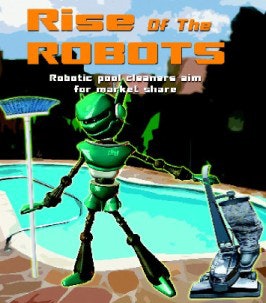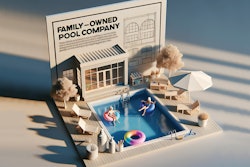
Sales of his company's robotic pool cleaners have doubled in the past three years, according to Gil Erlich of Aqua Products, Cedar Grove, N.J. And in Europe, he says, 50 percent of all new pool cleaners purchased are robotics. While not everyone agrees with that figure, one thing nearly everyone agrees on is that robotic automatic pool cleaners are gaining in popularity, acceptance and market share.
But don't abandon your suction-side and vacuum-side cleaner lines just yet. A full line of hose-operated and robotics gives dealers the tools they need to capture the full range of the market, from entry level to high-end upgrade.
"There's no question that the category has some wind behind its sails and has for a couple of years now," says Tom Wilhite, president of Aqua Vac, a Hayward company.
The fact that Aqua Vac is now a Hayward company is just one sign that the robotic cleaner category has a bright future. Hayward recently acquired the half-century-old company, thereby extending its offerings in automatic pool cleaners. Knowing a little more about these scrubbing robots and the people who buy them — or would buy them — provides dealers and builders the opportunity to give their customers more and give themselves bigger profits.
Industry experts agree on quite a few specifics: Robotic cleaners are a growing category. They are more dominant in the northeastern part of the United States and they are quite dominant in the European market. They are usually an aftermarket upgrade item for consumers. Price can be a barrier: While robots tend to appeal to clients with more disposable income, there's a big untapped market of pool owners who, with a little education, would move a robotic cleaner to the top of their wish lists.
Growing Market
Robotic cleaners have a strong foothold in Europe, where they compete successfully with other categories of cleaners. "It's much higher [market share] than it is in the United States, I think it's 30, 35 percent," says Wilhite. "The European market traditionally has been a higher-end pool market. The robotics are on the higher end and they were just accepted — they accepted the price point in Europe more than the U.S. did."
Guy Erlich, owner of WaterTech Corp., East Brunswick, N.J., agrees: "The Europeans are not as price-sensitive. They are willing to pay for quality," he says. "[In the United States], they're looking for what it's going to cost. There, the first question is, 'What's the quality?'"
While trends in the North American pool industry usually start on the West Coast and spread east, robotics claim the Northeast as ground zero in the U.S. "Robotic cleaners are getting more interest in the cleaner marketplace," says Brian King, senior product manager for Pentair Water, Pool & Spa in Sanford, N.C. "Once a mainstay [only] in the northeast, they are becoming more prevalent in the Midwest and Northwest."
"It's probably been increasing by about 25 percent each year [over the past five years or so]," says Gil Erlich.
Wilhite makes a similar observation, "The demographics are different. They spend more money in Europe and in the Northeast United States. It's the strongest robotic market in the United States by far."
"The Northeast has the most acceptance of robotic cleaners and it's growing through the Northeast, then the Midwest, then the Southeast and then other parts of the country," says Gil Erlich. "I think it's a couple of reasons. The big players are based in the Northeast. Aqua Products, SmartPool are here."
In addition to more exposure to the category, the Northeast has a demographic makeup that's conducive to accepting robotics, according to both Guy Erlich and Wilhite. "In the Northeast, people are much more adaptable to technology, they make decisions much faster, it's a more sophisticated market," says Erlich. "Also it has to do with median income. In the Northeast everything is just that much more expensive, so it's easier for them to want to spend the money."
Man Vs. Robot
Another factor in the distinct regionality of robots is the prevalence of affordable pool service in places where there are more pools and the season is year-round.
"In Sunbelt states and California, a pool service is a lot less expensive than it is in the Northeast," says Gil Erlich. "In Florida, it's a year-round season, whereas in New Jersey, it's just a few months. So a Jersey guy with a pool service has to charge a lot more money. In Florida, you can have 10 customers on one block. In New Jersey, if a guy services 10 pools, he probably has to drive to five different towns. So since it's so much more costly, people say, 'Whoa! Why don't I buy a robot for the same money.' Where a guy in Florida would say, 'My pool service is pretty cheap, why should I buy a robot.' So the mentality is very different. If they do buy pool cleaners in Florida, they tend to be the less-expensive type."
In places like Florida, too, a pool is less of a luxury item than it is in colder climes. "It's kind of like saying, anyone who has a house here in New Jersey has a lawn," says Erlich. "In Florida, anyone who has a house has a pool. Whether they want it or not, the pool comes with the house." As a result, consumers in the Northeast who own a pool are more likely to have more disposable income than pool owners in Florida.
Financial Fear
While it would be nice if all customers weren't price sensitive, cost is an obstacle for consumers and dealers alike. "I think any time you spend $1,000 instead of $400, there's a thought process behind it. It's certainly not an impulse buy," says Wilhite. And interestingly, sometimes consumers are willing, but dealers are shy of the price tag. "It's been a difficult battle for them to accept the price point," says Wilhite. "They've been accustomed to selling $300 and $400 cleaners for many years. But 20 percent of their consumers that walk in the store and want an automatic pool cleaner want a high-end robotic cleaner. If they aren't recognizing that part of the market then they're missing out on it, the guy's going somewhere else."
A problem for builders who might wish to sell robotics is a race-to-thebottom mentality that both Erlich and Wilhite have seen. "When the builder is sitting at the dining room table with mom and pop, trying to sell them a pool, and the guy who preceded him said, 'I'm going to give you an automatic pool cleaner,' then he's obligated to do that as well," he says. "Obviously, when it becomes a throwin, it's 'What can I buy cheapest.'" Wilhite says.
Gil Erlich has made the same observation. "It has nothing to do with the quality of the pool, but if I'm going to build a pool, I'm going to be in competition with somebody else," he says. "And that competitive builder says he's going to throw in a pool cleaner. So now everybody knows if they're going to build a pool, they have to throw in a pool cleaner because it has become the norm. So the builder knows he can put in a $100 pool cleaner or a $1,000 pool cleaner, and the customer probably won't know the difference. So the builder says, 'Why should I increase the price of my project $1,000 and lose the project?'"
Erlich notes one other obstacle that robotic cleaners have overcome. "I think it's important to let the readers know — especially readers that may have tried them 10 years ago and are gun shy — that things have changed," he says. "In the past, the quality wasn't there, the service wasn't there. When I started 25 years ago, the quality was terrible!" But today, that's not the case. He says one-year warrantees were the norm years ago, but now his company offers a fouryear warranty, and there are hundreds of service centers where there used to be just a handful.
But competition raises the bar, and these days, there's plenty of it in the segment. "It's not just that robotics are growing in popularity, it's also the competition has forced the companies to make a better product," says Erlich. "Today all the robotics coming out are much better than they ever were in the past, across the board for all of them. Today, because of competition, companies can't afford to have failures."
In fact, Erlich is happy to have Hayward as a competitor, "As far as the category is concerned, I think [Hayward's entry] is only going to help. The distribution system, plus with Hayward-dedicated customers throughout the country — and the world — who may not carry a robotic cleaner because they have been buying exclusively from Hayward, they might all of a sudden think, 'Now that it's available and I'm getting a truckload of Hayward things, throw on a couple of those robotic cleaners.' So I think it's just going to help the whole thing to grow," he says. "It's made me have to be better and offer a better warranty. Now it's a race to the top."
What's Ahead?
It's a good sign that sales are trending up while prices for robotics haven't moved much. That means that consumers are losing their fear of the price tag. "Will the price come down. I suspect it might in the future, but honestly in the 10 strong years of robotics starting to gain some momentum in the United States they haven't come down very much," says Wilhite. "They might have gone from $1,199 to $999, and in the next two to three to five years they may be headed to $799, but a robotic, just by the nature of what it is, manufacturing costs and the bill of materials, is always going to be the high-end cleaner. Somebody will figure out how to do a cheaper robotic without sacrificing performance and quality and the market will have to react to that."
Erlich thinks that price drop will come from China, as it has in so many other product categories. "It's definitely on the horizon. I believe that a lot of companies are looking for the perfect Chinese manufacturer behind the scenes and haven't found it yet," he says. "One of the companies is all of a sudden going to build in China and cut the price in half, and then all the others will say, 'Whoa, we have no choice,' It's only a matter of time. It's going to happen one year and it's going to catch everyone by surprise. And the reason it hasn't happened yet is that everyone is concerned about quality."
In the meantime, most dealers can sell a $1,000 cleaner as part of a range of offerings. There's a significant segment of the market that wants them. Wilhite sees it as a natural progression. "The customer that buys our high-end cleaner is stepping up, much like he bought a Ford then a Mercury and then a Lincoln.







































